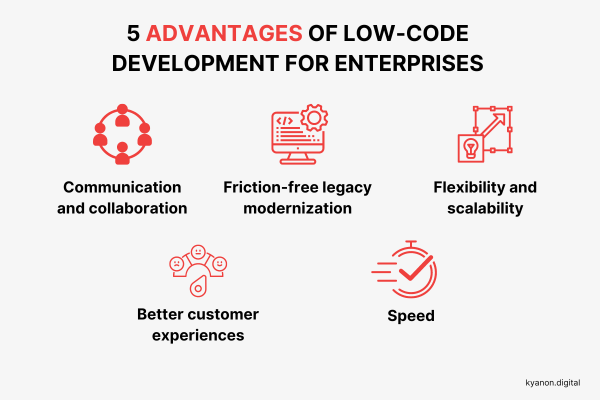Recommended Reasons To Picking Low-Code Platform Examples
Wiki Article
In Terms Of Integration Capabilities, Low-Code Application Development Has A Lot Of Advantages.
Low-code integration of applications has many advantages, including the ability to seamlessly integrate with multiple applications and systems. These are the advantages of pre-built APIs and connectors:
Connectors that are wide-ranging Low-code platforms have a vast collection of connectors that are pre-built for popular enterprise system (e.g. ERP, CRM databases, cloud services). This makes it easier for connecting these systems.
API Integration: A lot of low-code platforms have out-of the-box integration API capabilities that allow developers to connect easily with external data sources and services.
Simple to Utilize:
Drag-and-Drop Integration Tasks for integration can typically be accomplished using drag-and-drop interfaces, which makes it easy to both developers and non-developers to set up complicated integrations without writing a lot of code.
Visual Workflow Builders: These visual tools are used for designing workflows, data flow and integrations. They assist in understanding and setting up workflows more easily.
Standardized Integration Methods:
SOAP/RESTful Services Support: Standard web service protocols, like SOAP/REST, facilitate the integration of a variety of different systems and applications.
OData and Other Standards Support for standards like OData provides easy access to and manipulation of data across a variety of platforms and software.
Real-Time Data Synchronization:
Real-time Integrations: Low-code devices allow real-time data synchronization between applications and systems, ensuring that the data is always current and consistent across the organization.
Event-Driven Architect: A few platforms are equipped with structures that are event driven, allowing applications to respond instantly to any event. This is crucial in dynamic interactive applications.
Legacy System Integration:
Low-code platforms are often used to integrate legacy systems. This lets organizations upgrade IT infrastructures without having to completely overhaul existing systems.
Data Migration Tool: Built-in migration tools let data be transferred from legacy systems to new applications that run on low code platforms.
Third-Party Services Integration:
Cloud Services: Seamless Integration with Cloud Services such as AWS Azure Google Cloud and Google Cloud makes it easy to deploy applications.
Business Application Integration: Low-code platforms can integrate with various business software like Salesforce, SAP, Microsoft Dynamics, etc., enabling a cohesive workflow that is able to be used across various business functions.
Simple Data Management:
Unified Data Models Some low-code platforms have unified data models that simplify managing data and integrating across different systems.
Data Connectors Pre-configured data connectors enable users to access and manipulate data from many sources.
Security and compliance
Secure Integrations: Low-code platforms ensure that integrations conform to security protocols and standard, protecting data during transportation as well as during rest.
Compliance Features: These platforms typically include features to ensure that integrations meet regulations (e.g., GDPR, HIPAA), providing peace of mind for businesses handling sensitive data.
Extensibility:
Custom Code and Scripts: For more intricate integration requirements Low-code platforms typically allow the inclusion of custom scripts and code that allow for flexibility, without compromising ease of use.
Plug-in Ecosystems. A community of extensions and plug-ins will allow you to further enhance the capabilities of integration, while adding new functionalities whenever needed.
Overall, integration capabilities in low-code applications development platforms allow them to provide a robust platform for creating integrated efficient, scalable and connected applications. They can speed up the process of connecting disparate systems and enhance the flow of data. Businesses can also benefit from existing technologies and develop new ones while maintaining a cohesive IT environment. Read the top rated website about Low-code Platform for application development for site info including database in azure, low code development platforms, develop web application, azure sql server, develop web app, develop mobile application, jdbc server, low code platforms, rad application development, app dev platform and more.

Cost-Effectiveness Is Among The Many Advantages Of Developing Apps Using Low-Code.
Low-code applications offer a variety of advantages in terms of cost-effectiveness. Businesses that are looking to optimize budgets are able to benefit from this method while still delivering high-quality applications. Here are the top advantages: Lower development costs:
A Less Code Required Low-code platforms eliminate the need for extensive hand-coding, reducing the time and effort that developers need to put into developing applications. This results in less labor costs.
Reduced Developer Resources: Because low-code is more efficient and less time to create, less skilled developers will be required. This can cut down on hiring and staffing costs.
Faster time to market:
Development speed up Visual tools for development and pre-built components offered by platforms with low-code enable rapid application development, allowing companies to get their products on the market faster. This can result faster revenue generation and better position in the marketplace.
Rapid prototyping. By rapidly creating and testing prototypes, companies can speed up development and iterate faster based on user feedback.
Low Maintenance Costs
Simpler maintenance: Low-code platforms, with their standardised components and modular architecture, are easier to maintain. This means that they are less likely to require ongoing maintenance and support cost.
Automated Updates - Many low-code systems are capable of handling updates and patches in a way that is both secure and timely. This means that there is no necessity for manual intervention.
Efficient Resource Utilization:
Contributions from non-developers Low-code platforms enable non-developers and business users to take part in the process of development. This democratization allows businesses to use the skills of many employees, and lessen their dependence on highly paid programmers.
Optimized Use Of IT Resources: IT teams can concentrate on strategic projects instead of getting bogged down with mundane development tasks, increasing productivity and overall efficiency.
Modular Pricing Models that Scale:
Subscription Pricing: A lot of platforms with low-code offer flexible pricing models based on subscriptions that are scaled according to usage. This allows businesses the ability to adjust their spending in line with the growth of their business and its needs without the need for large upfront costs.
Pay-As-You-Go options Certain platforms allow businesses to pay only for what they use. This is particularly beneficial for startups or small companies with limited funds.
Reduce the costs of third-party software
Built-in Functionalities : A low-code platform typically comes with built-in functions and integrations, which eliminates the requirement for third-party tools, software and licenses.
Pre-Built Integrations: Having of pre-built integrations to popular services and systems reduces the need for custom-designed development. Savings on both time as well as cash.
Increased ROI
A faster return on investment: The combination of speedy development, lower costs, and a faster time to market means businesses can achieve a faster ROI (ROI) for their software.
Increased agility. Businesses are able to quickly adjust to the demands of customers and market trends to ensure they are relevant. They also can capitalize on new business opportunities as they occur.
The cost of training is cheaper:
User-friendly interfaces: Low-code systems provide user-friendly and easy interfaces that help reduce the learning curve. They also eliminate the requirement for lengthy training programs.
Accessible Resources. Many low-code platforms provide extensive training materials and tutorials as well as community support. They reduce the need to undergo formal training, which is costly.
Collaboration can be made easier.
Enhanced Collaboration Tools: Inbuilt tools for collaboration facilitate better communication and coordination among team members, resulting in more efficient development processes and less project overhead.
Unified Development Environment: A single unifying development environment can help simplify workflows and decreases the complexities and costs associated with managing multiple tools and platforms.
In the end, the value of low-code application development stems from its ability to cut the cost of development and maintenance and speed up time to market, optimize utilization of resources, as well as provide flexibility in pricing. This combination of factors offers companies significant financial advantages and makes low-code an appealing option for companies seeking to maximize development budgets, yet still creating robust and flexible applications. See the recommended the full report about Enterprise application development with Low-code Platform for blog advice including cross platform mobile app development, build with docker, rapid action development, cross platform app development, jdbc server, azure sql server, develop web app, develop web application, rad application development, cross platform app development and more.

The Benefits Of Low-Code Development For Application Development, In Terms Of Restrictions And Customization
The low-code method is a balanced method that permits significant customization and addresses weaknesses. These are the advantages:
The Challenge of Overcoming Complexity Barriers
Low-code development platforms are easy to use because they provide already-built components, templates and other tools. They also permit rapid deployment of even the most complex applications.
Guided Workflows: A lot of platforms offer guided workflows and wizards that help developers navigate through the maze of processes, decreasing the chance of making mistakes and guaranteeing consistency.
Solutions to scale:
Built-in Scalability: Low-code systems typically include features that allow scalable architecture, allowing applications to handle increased loads without major redevelopment.
Performance Monitoring Tools: Instruments for monitoring and enhancing performance are incorporated into the application to ensure it remains efficient regardless of the size.
Security and compliance
Low-code platforms are equipped with security options, such as role-based security access control as well as encryption and automated checks to ensure compliance. These security features address common concerns about security.
Regular updates: Platforms often upgrade their security protocols and compliance measures, ensuring that applications remain secure against new threats.
Customization capabilities:
Extensibility:
Low-code platforms can often be able to integrate custom code, like JavaScript or Python, allowing developers to expand their capabilities beyond the limitations of normal.
Customized plugins and modules: Developers can create custom modules or plugins to add specific functionalities tailored to unique business requirements.
APIs and integration:
API Support: Full API support permits seamless integration of external systems and services. This facilitates extensive customization and connectivity.
Third-Party Platforms Lowcode platforms usually come built with connectors for third-party applications. This makes it easier to integrate them and modify the app.
Flexible Design for UI/UX
Customizable User Interfaces: Developers are able to alter and design user interfaces that meet branding and usability specifications to create a custom user experience.
Responsive Design: Built-in responsive design capabilities ensure that applications can be customized for various screens and devices.
Custom Business Logic for Businesses:
Visual Workflow Builds Visual tools allow for the customization of workflows and business rules, and also to create complex, tailored procedures.
Platforms can be equipped with conditional Logic which permits the creation of custom scripts that address certain scenarios or business rules.
Data Management:
Custom Data Models: Developers are able to develop custom data models that fit specific needs of the application, ensuring that data handling is custom-made to meet the needs of business.
Advanced Data Processing : Integration with the latest tools and capabilities to process data allows customization in how the data is processed, analyzed and utilized in your application.
The balance between customization and limitations
Frameworks and Standards
Best Practices for Compliance Low-code platforms facilitate adhering to industry best practices and standards. This helps in maintaining high-quality, scalable, and secure applications.
Governance Frameworks Governance Frameworks: Integrated governance frameworks ensure that any modifications don't affect the integrity, conformity, or the security of an application.
Iterative Development & Feedback
Rapid prototyping: Being capable of rapidly prototyping and test customizations developers can refine their designs based on feedback from users to improve the application.
Continuous Improvement: Low-code platforms allow continuous improvement, allowing for ongoing customization and enhancement as the business needs change.
User Empowerment
Low-code platforms enable citizen developers through letting non-developers by using intuitive interfaces to modify applications, they broaden the pool contributors that can improve and customize apps.
Training and Support: A lot of platforms provide comprehensive training and support to help users make successful modifications that do not compromise the stability of the application or its performance.
Low-code applications provide a flexible framework that can be customized to meet specific needs. This balance enables businesses to develop and maintain applications which are functional, tailored to their particular requirements and meet the highest standards in terms of quality, security and scalability.
